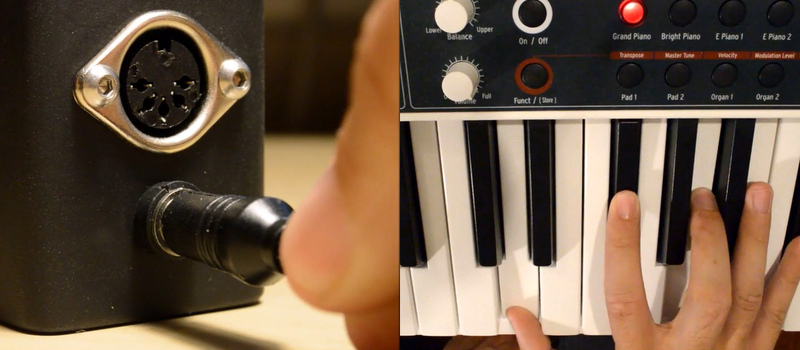If you like to read with gentle music playing, do yourself a favor and start the video while you’re reading about [Hugo Swift]’s MIDISWAY. The song is Promises, also by [SWIFT], which has piano phrases modulated during the actual playing, not in post-production.
The MIDISWAY is a stage-worthy looking box to sit atop your keys and pulse a happy little LED. The pulsing corresponds to the amount of pitch bending being sent to your instrument over a MIDI DIN connector. This modulation is generated by an Arduino and meant to recreate the effect of analog recording devices like an off-center vinyl or a tape that wasn’t tracking perfectly.
While recording fidelity keeps inching closer to perfect recreation, it takes an engineer like [Hugo Swift] to decide that a step backward is worth a few days of hacking. Now that you know what the MIDISWAY is supposed to do, listen closely at 2:24 in the video when the piano starts. The effect is subtle but hard to miss when you know what to listen for.
MIDI projects abound at Hackaday like this MIDI → USB converter for getting MIDI out of your keyboard once you’ve modulated it with a MIDISWAY. Maybe you are more interested in a MIDI fighter for controlling your DAW. MIDI is a robust and time-tested protocol which started in the early 1980s and will be around for many more years.















Wow! I have been noticing this annoying deviation in a few of today’s electronic artists. Like a VLFO or yes, the bad effects of tape or disc wow. Please stop.
You can just, uh, not listen to music you don’t like? Artists can do what they want, and if you don’t like it, that’s fine too.
Complaining about musical trends and tastes seems to work well. You should write a letter to your state and local counsel, that’s how I successfully got rid of autotune. Never heard of it? That’s because I wrote letters and complained and now it doesn’t exist! Us grandpas need to unite to fight against music and things we don’t like!
Thanks for your great work! Overdone autotune was the work of the devil. I’m so glad that I don’t hear it in every freaking song on the freaking radio, from country pop to R&B. Every freaking song. For like five years now. Thanks for that.
Compared to autotune, the wobbly detune effect is woefully underutilized. (Although Boards of Canada got some really good use out of it like 10-12 years ago: see “A Beautiful Place”, etc. You kids get off my lawn!)
You don’t hear overdone autotune in country music anymore? What little I have listened to (not a bash, it just isn’t my jam) still has that operatic, pitch perfect, sound to it. I expect that of Sarah Brightman, someone who trained for years to sing a song the same way every night for several nights a week. I don’t expect a new country singer, who got popular for singing almost breathless, heavily warbling, notes to suddenly be able to hit the same pitch, precisely, through each verse of a hit single.
Give me the days of country sounding like it was sung with less production than pop, and I’ll listen to more.
You are very welcome. I also spearheaded the successful efforts to keep Elvis (who?) from poisoning the youth and got the restraining order keeping rock 1000 meters from roll at all times. Persistence is key…
I suppose you you could also use it phase synced 180 degrees to the actual errors from your old tape or phono to correct it as well, maybe?
I’m wondering if you could use it for steganography.
By adjusting the playback speed slightly to encode data, right? I suppose that would be equivalent to low-depth FM modulation!
Not a fan personally, sounds like a piano in need of tuning.
Interesting toy and proof of concept, but not very practical. Most good MIDI computer programs will store any MIDI modifier data, and some will permit modulation of MIDI params with a virtual LFO. Also, one can use a pitch-shift plug-in in a multitrack audio program which can similarly be modulated by recorded or generated values.
Alternately you could whistle down a long tube.
From the authors website it looks like the prototype was designed to be used in a live show where MIDI computer programs aren’t available. The effect works in real-time. Not very useful for MIDI recording purposes but clearly not what it’s designed for.